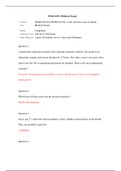Examen
NURS 6531 Midterm Exam (2 Versions, 200 Q & A ) / NURS6531N Midterm Exam (Year-2019/2020, 100 Q & A in Each Version, Verified and 100% Correct Answers)
- Cours
- Établissement
NURS 6531 Midterm Exam / NURS6531 Midterm Exam (Latest): Walden University Walden NURS 6531 Midterm Exam / Walden NURS6531 Midterm Exam (Latest) Question 1 A patient has experienced nausea and vomiting, headache, malaise, low grade fever, abdominal cramps, and watery diarrhea for 72 hours. His wh...
[Montrer plus]



